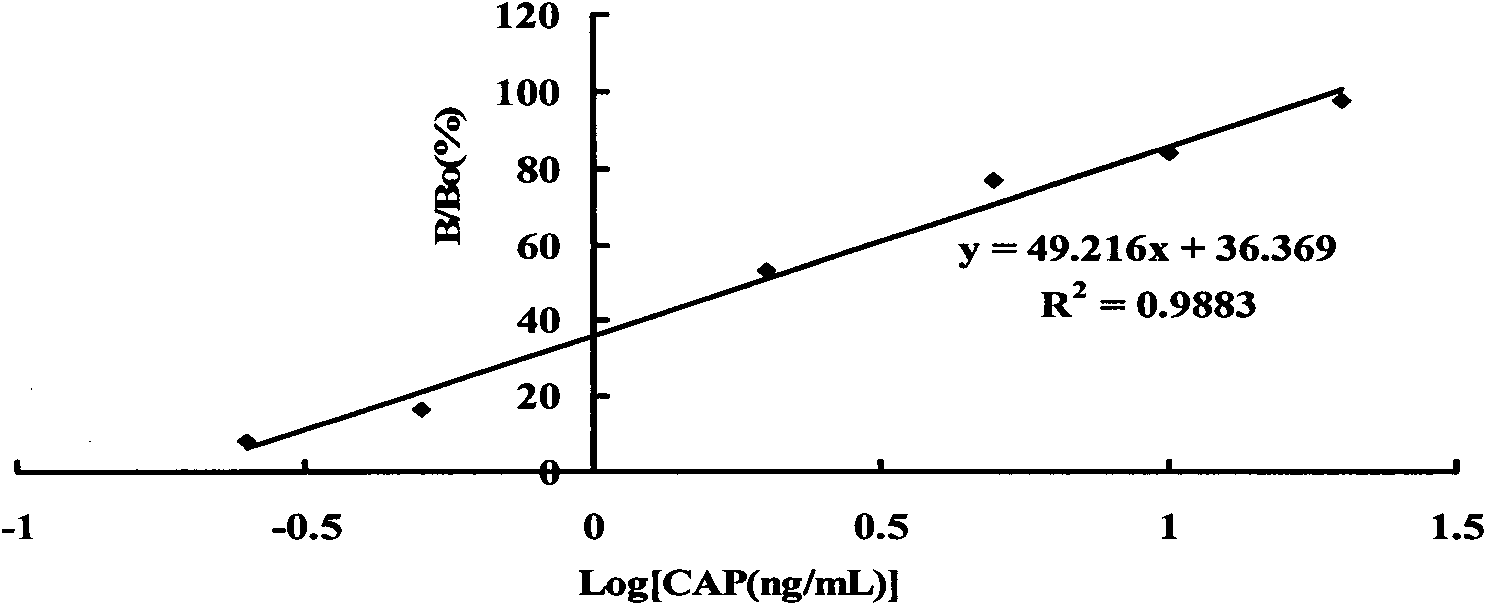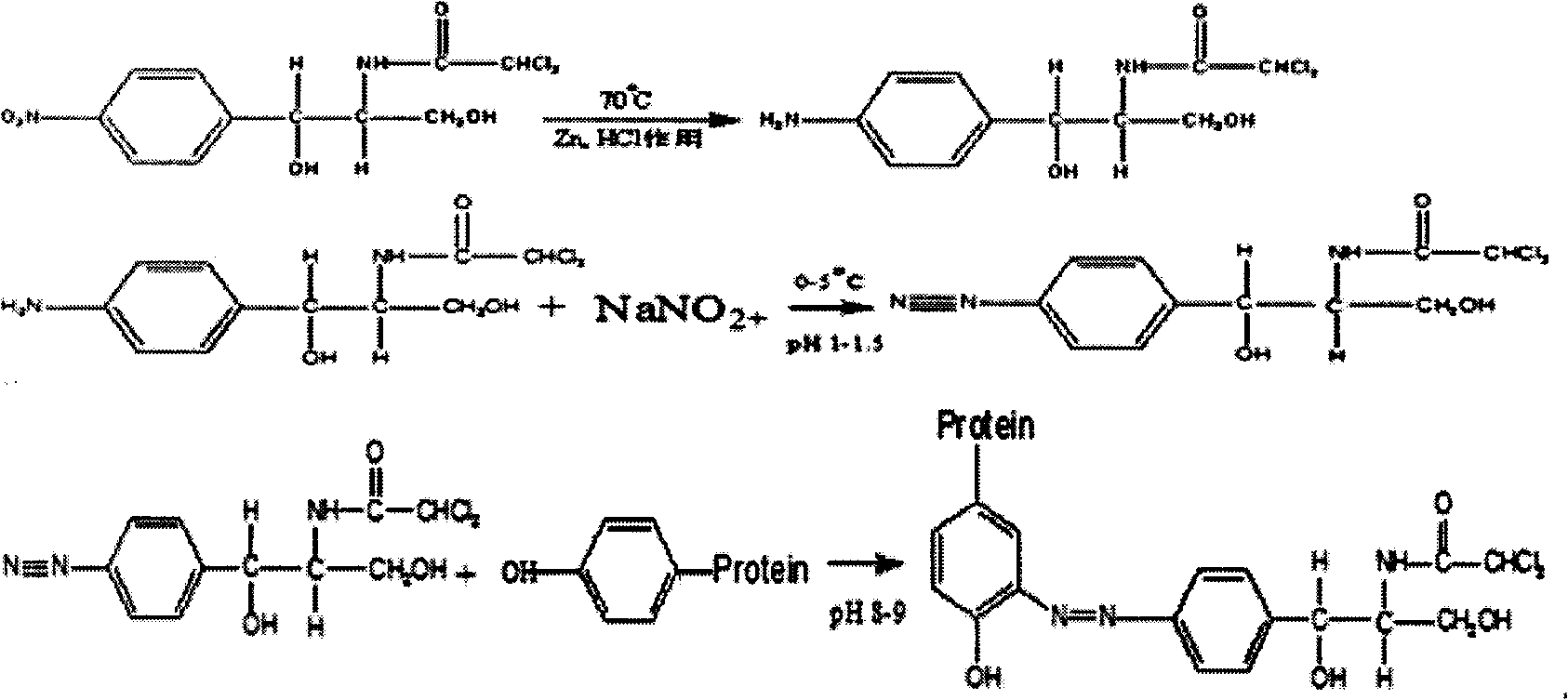Enzyme-linked immunosorbent assay kit for analyzing chloramphenicol residues based on rabbit monoclonal antibody
An enzyme-linked immunosorbent assay and monoclonal antibody technology, applied in the direction of analytical materials, measuring devices, instruments, etc., can solve problems that have not been reported before, and achieve the effect of reducing detection costs
- Summary
- Abstract
- Description
- Claims
- Application Information
AI Technical Summary
Problems solved by technology
Method used
Image
Examples
Embodiment 1
[0027] Embodiment 1: the synthesis of chloramphenicol immune antigen and coating antigen
[0028] The specific operation steps are as follows: Take 80 mg of small CAP molecules, dissolve them in 1.5 mL of absolute ethanol, and add 12 mL of 1mol / L hydrochloric acid. Add 65mg of zinc powder and heat in a water bath at 70°C for 50min. After cooling, add 0.5mol / L NaNO dropwise at 4°C and pH 1-2 2 Add a few drops, and stir in the dark until the starch potassium iodide test paper turns grayish blue (solution I); weigh 150 mg of BSA, dissolve it in 12 mL of phosphate buffer (PBS, pH 7.4), and cool. (solution II). Then slowly add liquid I into liquid II while stirring, and at the same time add 0.2mol / L NaOH solution to keep the pH at around 7-8. Stirring at 4°C for 12h, the reaction product was dialyzed against PBS for 5d. The coating antigen OVA-CPFX was prepared in the same way and used to coat the microtiter plate.
[0029] The coupling principle of chloramphenicol and carrier...
Embodiment 2
[0031] Example 2: Production of Chloramphenicol Rabbit Monoclonal Antibody
[0032] 1. Immunization of rabbits
[0033] For primary immunization, mix 500 μg of immune antigen with an equal amount of Freund’s complete adjuvant, and after complete emulsification, inject white rabbits (1 mL / only) subcutaneously at 5 points on the back; three weeks later, use 200 μg of immune antigen with Freund’s incomplete adjuvant After mixing, carry out the second immunization in the same way; after that, immunize once every two weeks. After a total of 3 to 7 immunizations, when the serum titer reaches 64,000 or more, inject 500 μg of immune antigen into the ear vein, and collect whole blood from the carotid artery 4 days later. , take the spleen aseptically and prepare for cell fusion.
[0034] 2. Preparation of rabbit monoclonal antibody
[0035] The rabbit splenic lymphocytes were fused with 240E cells in the logarithmic growth phase, and the fusion agent was 50% PEG. The fused cells use...
Embodiment 3
[0036] Embodiment 3: the coating of microtiter plate
[0037] Chloramphenicol coated antigen was diluted to 0.2 μg / mL with pH9.6, 0.05mol / L carbonate buffer (containing 2.93g sodium bicarbonate and 1.59g sodium carbonate, dissolved in double distilled water or ultrapure water 1L) , add 50 μL to each well of the ELISA plate, coat at 4°C for 12 hours or 37°C for 2 hours, pour off the coating liquid, wash with PBST for 3 to 5 times, pat dry, and then add 250 μL of 3% degreasing to each well Milk, sealed at 37°C for 1 hour, washed 3 to 5 times after taking out, dried and sealed for storage.
PUM
| Property | Measurement | Unit |
|---|---|---|
| coefficient of variation | aaaaa | aaaaa |
Abstract
Description
Claims
Application Information
 Login to View More
Login to View More - R&D
- Intellectual Property
- Life Sciences
- Materials
- Tech Scout
- Unparalleled Data Quality
- Higher Quality Content
- 60% Fewer Hallucinations
Browse by: Latest US Patents, China's latest patents, Technical Efficacy Thesaurus, Application Domain, Technology Topic, Popular Technical Reports.
© 2025 PatSnap. All rights reserved.Legal|Privacy policy|Modern Slavery Act Transparency Statement|Sitemap|About US| Contact US: help@patsnap.com



